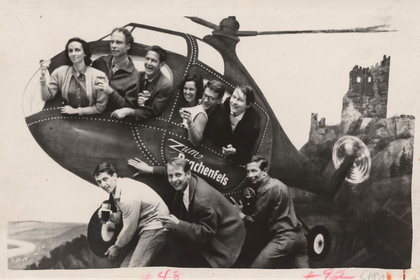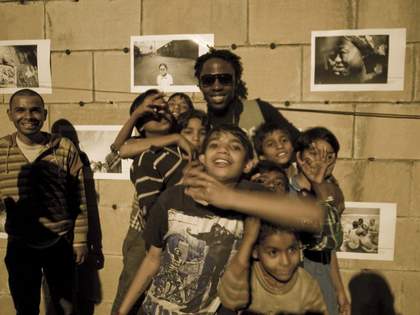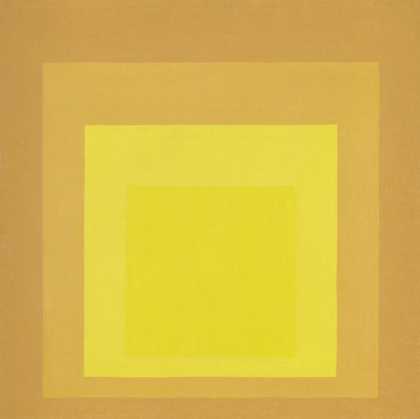
Merce Cunningham Dance Company world tour, Cologne, 1964. Pictured in helicopter: Carolyn Brown, Merce Cunningham, John Cage, Doris Stockhausen, David Tudor, and Karlheinz Stockhausen. Pictured below: Steve Paxton, Michael von Biel, and Rauschenberg. Photo: Unattributed
The 1950s was a decade of contradictions, simultaneously future-focused and nostalgic. Though the Second World War was over, the Cold War threat of nuclear annihilation loomed over the Western world, to say nothing of Japan, the country that had actually experienced the horror of the A Bomb. During the 1940s, women had experienced growing independence and taken on varied war work. Now, however, the fear that veterans would not have jobs to return to forced many women back into a restricted housewife role. The slick new breed of ad men began churning out propaganda to make sure everyone knew their place. Super feminine fashions were back, with Dior's New Look of wide skirts and waspy waists. The Ideal Home shows presented shiny new versions of the labour-saving future, but many were in reality still dealing with the aftermath of the past, with rationing in the UK continuing to the mid-fifties.#
Television was overtaking radio as the new mass medium, teenagers were hanging out in coffee bars and milk parlours, and Elvis was perfecting his controversial hip-swivels. In this context of societal change and new ways of consuming media and messages, the world of experimental performance, music and art was starting to make waves.
The Black Mountain College in North Carolina was the hot house for avant-garde and experimental work. Set up in the 1930s by John A Rice, it was a liberal arts college based on the progressive education principles of John Dewey and placed a high value on arts as an integral and indispensable part of the curriculum. During the thirties and forties, influential European artists and designers found a home there, fleeing Nazi persecution. Josef Albers was the first art teacher, bringing knowledge and principles from the Bauhaus.
Dancer and choreographer Merce Cunningham and composer and musician John Cage were already working together when they first came to Black Mountain in 1948 and reconstructed Erik Satie’s The Ruse of the Medusa with collaborators including Buckminster Fuller, Elaine and Willem de Kooning. On their return in 1952 they worked with others including pianist David Tudor and artist Robert Rauschenberg. Together, though orchestrated by Cage, this group created what could be called the first ‘happening’, an untitled event (now sometimes known as Theatre Piece no.1) in the college dining hall. A number of performances took place within a choreographed time bracket, but without narrative or causal relation to each other. Though few were there in the audience, the ripples of the event played out through the following decades in avant-garde performance.
Cage’s experimental music often took everyday sound or ‘found sound’ and re-presented it, highlighting the music in the ‘noise’ we normally would ignore.
I became an assistant to Oskar Fischinger, the filmmaker, to prepare myself to write the music for one of his films. He happened to say one day, “Everything in the world has its own spirit which can be released by setting it into vibration.” I began hitting, rubbing everything, listening, and then writing percussion music, and playing it with friends.
His most famous work, 4’ 33” was the furthest extension of finding sound, a piece in three movements where ‘no sounds are intentionally produced’, which David Tudor interpreted first for the piano. Everything the audience heard in those minutes was music. Cage’s work didn’t meet with universal approval in the TV dinner world of the 50s, though the piece Water Walk was enjoyed by those who watched in this game show studio audience.

Costumes and set, entitled Tantric Geography, designed by Rauschenberg for Merce Cunningham Dance Company’s Travelogue 1977. Photo: Charles Atlas.
Cunningham had studied with the influential American dancer Martha Graham, who had created a new language of dance – an expressive form, not driven by codes, but finding its own rhythms – as others like Rudolf Laban and Mary Wigman had with Expressionist Dance in Europe. Cunningham broke away from the dramatic narratives Graham’s company worked with and, crucially, away from the use of music to provide a rhythmic structure to the movements. Cunningham’s choreography looked to everyday movements: walking, running, bending, leaping and stretching. No more en pointe ballet feet and arabesques or fairy tale storylines, these dances were about the movements humans make, about dance itself.
It occurred to me that the dancers could do the gestures they did ordinarily. These were accepted as movement in daily life, why not on stage?
Working together in the late 1940s and early 1950s (and throughout their rest of their lives) Cage and Cunningham collaborated on music and dance pieces that, while they occured together in the same space and time, were conceived independently. They also drew upon Oriental philosophies of Zen Buddhism and the I Ching to incorporate chance and indeterminacy into their works. When the Merce Cunningham Dance Company began in 1953, Cage was the musical director and Rauschenberg the décor and costume designer. Their influence on the art world back then, as well as the world of avant-garde performance and experimental music today, is startling.

